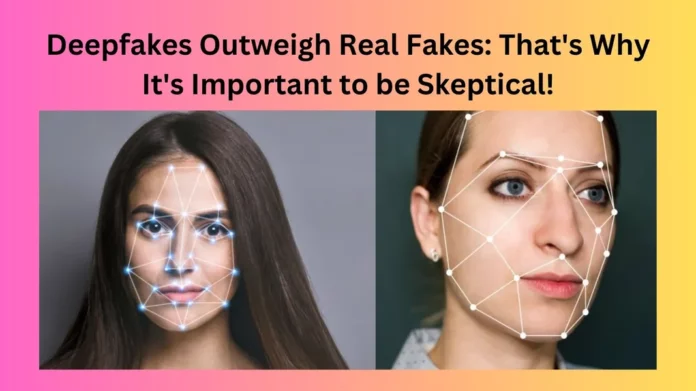In a world where technology continues to advance at an unprecedented pace, the rise of deepfakes has become a pressing concern. The ability to manipulate audio and video content to create incredibly realistic yet entirely fabricated material has opened new doors for both creativity and deception.
In this article, we’ll delve into the realm of deepfakes, exploring their impact on our lives and emphasizing the importance of adopting a skeptical mindset.
Understanding Deepfakes
What Are Deepfakes?
To start, let’s break down what deepfakes are. Deepfakes are synthetic media, generated using artificial intelligence (AI) algorithms to replace faces and voices in existing video or audio content. The term is a portmanteau of “deep learning” and “fake,” reflecting the sophisticated technology behind these manipulations.
The Technology Behind Deepfakes
Deepfakes utilize deep neural networks, leveraging machine learning techniques to analyze and replicate patterns in data. This allows the algorithm to learn and mimic the mannerisms, facial expressions, and vocal nuances of a target individual. The result is a convincing digital replica that can be indistinguishable from the real thing.
The Impact of Deepfakes
Deepfakes in the Digital Landscape
As the technology behind deepfakes continues to evolve, their presence on the internet has become more prevalent. Social media platforms, news outlets, and even personal communication channels are susceptible to the dissemination of misleading content. The ease with which deepfakes can be created raises concerns about their potential impact on public opinion and trust.
Deepfake Vulnerabilities
While deepfakes are becoming increasingly sophisticated, they are not infallible. There are telltale signs that can help identify manipulated content, such as unnatural facial movements, inconsistent lighting, or glitches in the audio. Being aware of these vulnerabilities is crucial in developing a skeptical eye when consuming digital media.
Why Skepticism Matters
Preserving Truth and Authenticity
In a world inundated with information, being skeptical is a powerful tool for preserving truth and authenticity. By approaching digital content with a critical mindset, individuals can navigate the digital landscape more confidently, distinguishing between genuine and manipulated media.
Protecting Personal and Professional Reputations
The consequences of falling victim to deepfake misinformation can be severe. Individuals may find themselves at the mercy of false narratives, risking damage to personal and professional reputations. Skepticism acts as a shield, allowing individuals to question the veracity of content before accepting it as truth.
Cultivating a Skeptical Mindset
Fact-Checking in the Digital Age
In the era of deepfakes, fact-checking has become an essential skill. Engaging in a quick online search or using dedicated fact-checking websites can help verify the authenticity of a piece of content. Taking these extra steps can make the difference between perpetuating a falsehood and preventing its spread.
Questioning the Narrative
It’s crucial to question the narrative presented in digital content. Who stands to benefit from the dissemination of a particular piece of information? What motives might be at play? Asking these questions can uncover hidden agendas and contribute to a more nuanced understanding of the content in question.
The Road Ahead
Technological Countermeasures
As deepfake technology advances, so do efforts to counteract its negative implications. Researchers and tech companies are investing in developing tools and algorithms to detect and mitigate the impact of deepfakes. Staying informed about these advancements can further empower individuals to protect themselves from the potential harm caused by manipulated content.
Digital Literacy Education
Promoting digital literacy is paramount in the fight against deepfake deception. Educational initiatives that teach individuals how to identify and critically assess digital content contribute to a more resilient and skeptical society.
Conclusion
In conclusion, the prevalence of deepfakes in today’s digital landscape necessitates a heightened level of skepticism. By understanding the technology behind deepfakes, recognizing their impact, and cultivating a skeptical mindset, individuals can navigate the online world more safely. As technology continues to evolve, staying informed and embracing a critical approach to digital content is essential for preserving truth and authenticity.
Frequently Asked Questions (FAQs)
1. How can I identify a deepfake?
- Look for unnatural facial movements, inconsistent lighting, or glitches in the audio. Additionally, consider using online tools and fact-checking websites.
2. Are there any legal consequences for creating or sharing deepfakes?
- Yes, many jurisdictions have laws against the creation and dissemination of deepfake content, especially if it involves malicious intent or harm.
3. Can deepfake detection tools be trusted?
- While detection tools are continually improving, it’s essential to stay updated on the latest advancements and use multiple methods for verification.
4. Are there any positive applications of deepfake technology?
- Yes, deepfake technology has potential positive uses, such as in the entertainment industry for creating realistic special effects or in voice synthesis for aiding individuals with speech disorders.
5. How can I protect myself from falling victim to deepfake misinformation?
- Stay informed about the latest deepfake trends, educate yourself on digital literacy, and always fact-check suspicious content before sharing or believing it.















